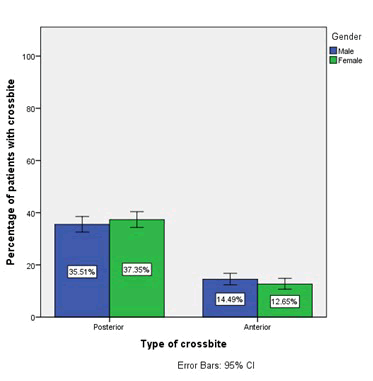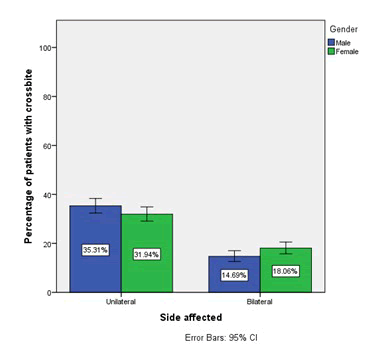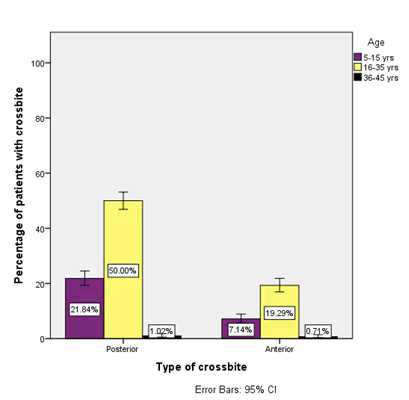Research Article - (2022) Volume 10, Issue 5
A Study Assessing the Prevalence of Crossbite among Patients Reporting for Orthodontic Treatment and its Association with Different Factors
Remmiya Mary Varghese* and Sharon Keziah V
*Correspondence: Remmiya Mary Varghese, Department of Orthodontics, Saveetha Institute of Medical and Technical Science, Saveetha University, Chennai, India, Email:
Abstract
Objective: To assess the prevalence of crossbite among patients reporting for orthodontic treatment and its association with different factors.
Materials and Methods: 980 subjects (490 men, 490 women) aged 5-45 years were evaluated to determine the prevalence of crossbite in a South Indian population. The patients were classified accordingly into 3 dentition stages (primary, mixed and permanent), unilateral or bilateral crossbite, anterior or posterior crossbite. The results were analysed using SPSS version 22.
Results: The overall prevalence of crossbite was found to be 8:30%. The most common age group affected was 16-30 years old. Posterior crossbite was more prevalent with 72%. There was a higher frequency of unilateral crossbite. There was a significant association between the type of crossbite and gender, with posterior crossbite more commonly in females, p=0.03.
Conclusion: An increasing prevalence of crossbite was observed from the primary dentition towards permanent dentition in this study.
Keywords
Epidemiology, Innovative study, Malocclusion, Posterior crossbiteIntroduction
Crossbite is an abnormality in the buccolingual relationship between upper and lower teeth that requires an early intervention to prevent further discrepancy in the growth of the maxilla and mandible [1]. The discrepancy can be unilateral, bilateral, anterior or posterior. The mode of treatment for transverse maxillary deficiencies is rapid or slow maxillary expansion [2]. There are many factors that might lead to the development of crossbite such as heredity, dental arch length, retained deciduous or supernumerary teeth, thumb sucking habit, Skeletal-anteroposterior abnormality and cleft lip and palate [3].
Previous literature conducted by Bell and Kiebach in 2014 observed the prevalence of posterior crossbite is higher in deciduous and mixed dentition, with a prevalence in the age range of 3 to 12 years. Furthermore they also concluded that a high prevalence of 90% of functional crossbites [4]. Another study showed higher evidence of bilateral crossbite among the turkish population in the permanent dentition [5]. Untreated unilateral or bilateral posterior crossbite in a child result in transition to adulthood leading to mandibular asymmetric development [6].
The condition where one or more of the upper incisors are in linguo-occlusal relationship is known as anterior crossbite, that mainly is prevalent in the primary and mixed dentition. It can be due to the disharmony between the dental, skeletal and functional components [7]. There is usually a straight profile in centric relation with class 1 molar and canine relation. However, there can be pseudo class III or in some cases functional anterior crossbite that might be caused because of mandibular hyper propulsion, in turn causing the position of the tongue to have premature canine contact that entraps the maxilla [8]. In these cases, there will be an edge to edge relation of the incisors in the centric position along with class 3 relationships [9].
Another type of crossbite is the skeletal anterior crossbite that is skeletal anterior crossbite is specified by class III centric relation, where an edge to edge incisor relationship cannot be obtained [10]. During the course of treatment, the maxillary expansion will be more stable if the teeth to be moved are first tilted palatally. Coffin spring, SARPE (surgically assisted rapid maxillary expansion), Quad helix, Ni Ti palatal expander are the frequently used appliances for the expansion procedure. There is usually a concave profile with a retrusive upper lip and predominant chin in a skeletal anterior crossbite [11].
Although the maxillary expansion has been quite successful, there have [12] also been incidences of relapse. There was a higher relapse rate in the early mixed dentition. Previous literature have reported a 50% prevalence of re-treatment of crossbite in the early or late mixed dentition [13,14].
The data and studies that show the prevalence of crossbite in different age groups or dentition are important data for the diagnosis, etiologies of orthodontic anomalies, treatment and management strategies, and necessary public health resources. The aim of this study was to evaluate the prevalence of crossbites in patients reporting for orthodontic treatment and to assess the factors associated with it
Materials and Methods
This study was designed as a retrospective cross sectional study analysing all the patients who had crossbite. The data of patients between the age of 6 years and 35 years undergoing orthodontic treatment from June 2020 to March 2021 for crossbite were selected in the study. The records with incomplete medical documentation, replication of results in different time periods with improper clinical photographs or diagnosis were excluded from the study. Patient details like age, gender, type of dentition, anterior or posterior crossbite were included. The prevalence of cross bite among male and females was determined. The collected data was described in the form of frequency distribution and percentile. Statistical analysis was done using Statistical Package for the Social Sciences (SPSS). A Chi square test was applied to determine the significance between groups. P value <0.05 was considered to be statistically significant with a confidence interval of 95%.
Results
The overall prevalence of crossbite was found to be 8.30%. There were a total of 980 patients who were diagnosed with crossbite, among which 490 were men and 490 were women. The age group of the patients varied from 5-45 years, where almost 70% of the study population belonged to the age group 16-35 yrs. Posterior crossbite was more prevalent with 72.86% than anterior crossbite. Unilateral crossbite was more common than bilateral crossbite among the patients. Majority of the patients were in the permanent dentition period when seeking treatment for crossbite. There was a significant association between gender and type of crossbite, where posterior crossbite was more common among the females whereas anterior crossbite was more common among the male patients, p=0.03 (Figure 1).
Figure 1: Bar graph showing the association between type of crossbite and gender. X axis represents the type of crossbite as posterior and anterior and Y axis the percentage of patients with crossbite. Blue bar denotes male and green bar denotes female. Posterior crossbite was more common among females than in male with 37.35%. The association between the type of crossbite and gender was found to be statistically significant. Pearson Chi square test, p=0.03 (p<0.05, statistically significant).
The association between gender and side affected in crossbite showed a significant relation, where male had 35.31% unilateral crossbite whereas female had only 14.69% prevalence (Figure 2).
Figure 2: Bar graph showing the association between side affected and gender. X axis represents the side affected as unilateral or bilateral and Y axis the percentage of patients with crossbite. Blue bar denotes male and green bar denotes female. Unilateral crossbite was more common among males than in females with 35.31%. The association between the side affected and gender was found to be statistically significant. Pearson Chi square test, p=0.0027 (p<0.05, statistically significant).
The association between the age group and type of crossbite showed higher occurrence of posterior (50%) and anterior crossbite (19.29%) among the age group 16-35 years. However there was no significant relation, p=0.1 (p>0.05) (Figure 3).
Figure 3: Bar graph showing the association between type of crossbite and age of the patients with crossbite. X axis represents the type of crossbite and Y axis the percentage of patients with crossbite. Purple bar denotes 5-15 years, yellow denotes 16-35 yrs. and black denotes 36-45 years. Posterior and anterior crossbite was the most common in the 16-35 yrs. olds. However, there was no significant difference in the prevalence of type of crossbites among the age groups. Pearson Chi square test, p=0.1 (p>0.05, statistically not significant).
Discussion
There is a notion among dentists that malocclusion does not depict a special characteristic of the permanent dentition, but can be seen in the stages prior to attaining the occlusal maturity. The causes of crossbite can be dental, skeletal or functional [15]. In the present study there was an overall prevalence of crossbite of 8.30% among all the malocclusions that were diagnosed. This was much lower than a previous study conducted previously by Kutin, where the prevalence of crossbite was 54% [16]. Few other literatures conducted among the Turkey and French population showed a prevalence of 27.4% and 15.4% respectively [17,18].
There was a higher prevalence of crossbite unilaterally (67.24%) than bilaterally in the present study. This was much higher than previous studies that were conducted in the Turkish population, where the prevalence of unilateral crossbite was only 15.3% and bilateral posterior crossbite was 5.8% [18]. Another study by Sultana found a 20% prevalence of unilateral crossbite in their study [19]. Most of the other studies showed a lower prevalence of unilateral crossbite compared with our study.
In this posterior crossbite was more prevalent than anterior crossbite. There was also a significant association between gender and type of crossbite, where posterior crossbite was more frequently seen among females. Among 511 subjects in the French population in a previous study, there was a 4.1% prevalence of posterior crossbites and only 2.2% of anterior crossbite [19,20]. Another study reported an 11.65% prevalence of unilateral posterior crossbite and 1.19% bilateral posterior crossbite [21].
This study showed a relatively higher prevalence of posterior crossbite when compared to anterior crossbite. Contradictory to these findings, there was a higher prevalence of anterior crossbite among females reported in the study conducted by Carlo [22]. There was also a higher prevalence of crossbite in the permanent dentition when compared to the primary and mixed dentition in the present study, indicating the lack of treatment in the primary or early mixed dentition that has resulted in the transitioning of the malocclusion in the permanent dentition [23-29].
Crossbites require professional assistance as early as possible, either in the primary dentition stage or in the early mixed dentition through counselling combined with or without interceptive orthodontics [22,30]. This intervention is required to prevent further growth or dent skeletal alternations that cause defects in swallowing and speech of the patient.
Studies that are conducted based on a particular region or place give a significant amount of information; basis may give significant information about the prevalence and changes in pattern of malocclusion that aids in the diagnosis and planning of treatment.
Conclusion
This study showed a higher prevalence of unilateral posterior crossbite. There was also a higher prevalence of crossbite in the permanent dentition. Epidemiological prevalence studies help in the resource planning, diagnosis and treatment planning for crossbite malocclusions. The present suggests lack of awareness about the seriousness or severity of their dental condition in the early stages. This may be attributed to their weak oral health knowledge and parent’s negligence toward malocclusion.
Acknowledgements
This research was done under the supervision of the Department of Orthodontics, Saveetha dental College and Hospital. We sincerely show gratitude to the corresponding guide who provided insight and expertise that greatly assisted the research.
Conflict of Interest
There was no potential conflict of interest.
Source of Funding
- Saveetha Institute of Medical and Technical Sciences
- Saveetha Dental College & Hospitals
- Saveetha University
- Kumar Automobiles, Chennai.
References
- Christie KF, Boucher N, Chung CH. 'Effects of bonded rapid palatal expansion on the transverse dimensions of the maxilla: A cone-beam computed tomography study'. Am J Orthod Dentofacial Orthop 2010; 79-85.
- Sollenius O, Petren S, Bondemark L. 'An RCT on clinical effectiveness and cost analysis of correction of unilateral posterior crossbite with functional shift in specialist and general dentistry'. Eur J Orthod 2020; 42:44-51.
- Gupta S, Kapoor S, Sait H, et al. 'Dental phenotype of multiple impacted supernumerary teeth in Wiedemann-Steiner syndrome'. Cleft Palate Craniofac J 2020; 59.
- Perrotta S, Bucci R, Simeon V, et al. 'Prevalence of malocclusion, oral parafunctions and temporomandibular disorder-pain in Italian schoolchildren: An epidemiological study'. J Oral Rehabil 2019; 46:611-616.
- Doriguetto PVT, Carrada CF, Scalioni FAR, et al. 'Malocclusion in children and adolescents with Down syndrome: A systematic review and meta-analysis'. Int J Paediatr Dent 2019; 29:524-541.
- Asiry MA, AlShahrani I 'Prevalence of malocclusion among school children of Southern Saudi Arabia'. J Orthod Sci 2019; 8:2.
- Soxman JA, Wunsch PB, Haberland CM. Anomalies of the Developing Dentition: A Clinical Guide to Diagnosis and Management. Springer 2018.
[Crossref][Google Scholar][Indexed]
- Bishara SE, Warren JJ, Broffitt B, et al. 'Changes in the prevalence of non-nutritive sucking patterns in the first 8 years of life.' Am J Orthod Dentofacial Orthop 2016; 31-36.
- Warren JJ, Bishara SE. 'Duration of nutritive and nonnutritive sucking behaviors and their effects on the dental arches in the primary dentition'. Am J Orthod Dentofacial Orthop 2002; 347-356.
- Chevitarese ABA, Della Valle D, Moreira TC. 'Prevalence of malocclusion in 4-6 year old Brazilian children'. J Clin Pediatr Dent 2003; 81-85.
- Kheirandish-Gozal L, Gozal D. Sleep Disordered Breathing in Children: A Comprehensive Clinical Guide to Evaluation and Treatment. Springer Science and Business Media. 2012.
- Harrison JE, Ashby D. 'Orthodontic treatment for posterior crossbites', Cochrane Database of Systematic Reviews 2001.
- Katz CRT, Rosenblatt A, Gondim PPC. 'Nonnutritive sucking habits in Brazilian children: effects on deciduous dentition and relationship with facial morphology'. Am J Orthod Dentofacial Orthop 2004; 53-57.
- Varghese RM, Subramanian AK, Sreenivasagan S. 'Comparison of dentoskeletal changes in skeletal class II cases using two different fixed functional appliances: Forsus fatigue resistant device and powerscope class II corrector-A clinical study'. Int J Oral Health Dent 2021; 13:234.
- Arber S, Ginn J. Gender and Later Life: A Sociological Analysis of Resources and Constraints. Sage Publications (CA). 1991.
- Kutin G, Hawes RR. 'Posterior cross-bites in the deciduous and mixed dentitions'. Am J Orthod 1969; 56:491-504.
- Mtaya M, Brudvik P, Astrom AN. 'Prevalence of malocclusion and its relationship with socio-demographic factors, dental caries, and oral hygiene in 12 to 14-year-old Tanzanian schoolchildren'. Eur J Orthod 2009; 467-476.
- Nur B, Ilhan D, Fisekcioglu E, et al. 'Prevalence of Orthodontic Malocclusion and Evaluation Criteria in 7 Geographic Regions of Turkey', Turk J Orthod 2013; 154-161.
- Sultana N, Hassan GS, Jha D, et al. 'Prevalence of Cross Bite among the Orthodontic Patients in Bangabandhu Sheikh Mujib Medical University', Bangladesh J Medic 2015; 9-12.
- Bs P, Phulari BS, Naik P. 'Management of Crossbite', Orthodontics: Principles and Practice 2017; 428-428.
- Kumar S. 'Crossbite: An Orthodontic Exigency', J Clin Diagn Res 2016.
- Carlo GD, Saccucci M, Luzzi V, et al. 'Prevalence of maxillary canine impaction in skeletal Class III malocclusions compared to Class I malocclusions'. J Clin Exp Dent 2019.
- Bogomolov V. The Moment of Truth: A Novel and Two Stories. 1982.
- Effects of bonded rapid palatal expansion on the transverse dimensions of the maxilla: A cone-beam computed tomography study'
- Prabhakar H, Ali Z. Textbook of Neuroanesthesia and Neurocritical Care: Volume II-Neurocritical Care. Springer 2019.
[Crossref][Google Scholar][Indexed]
- Chandrasekar R, Chandrasekhar S, Sundari KKS, et al. 'Development and validation of a formula for objective assessment of cervical vertebral bone age', Prog Orthod 2020.
- Adel S, Zaher A, Harouni NE, et al. 'Robotic Applications in Orthodontics: Changing the Face of Contemporary Clinical Care', Bio Med res int 2021; 9954615.
- Alam MK, Alfawzan AA, Haque S, et al. 'Sagittal Jaw Relationship of Different Types of Cleft and Non-cleft Individuals', Front Pediatr 2021.
- Sillman JH. 'Serial Studies of Changes in Dimensions of the Dental Arches from Birth to Nine Years', Child Development 1947; 106.
[Crossref][Google Scholar][Indexed]
- 'Serial models illustrating some spontaneous changes in the deciduous dentition'. Am J Orthod 1961; 788-789.
Author Info
Remmiya Mary Varghese* and Sharon Keziah V
Department of Orthodontics, Saveetha Institute of Medical and Technical Science, Saveetha University, Chennai, IndiaCitation: Remmiya Mary Varghese, Sharon Keziah V, A Study Assessing the Prevalence of Crossbite among Patients Reporting for Orthodontic Treatment and its Association with Different Factors, J Res Med Dent Sci, 2022, 10 (5): 019-025.
Received: 21-Feb-2022, Manuscript No. 46928; , Pre QC No. 46928; Editor assigned: 23-Feb-2022, Pre QC No. 46928; Reviewed: 09-Mar-2022, QC No. 46928; Revised: 22-Apr-2022, Manuscript No. 46928; Published: 04-May-2022



